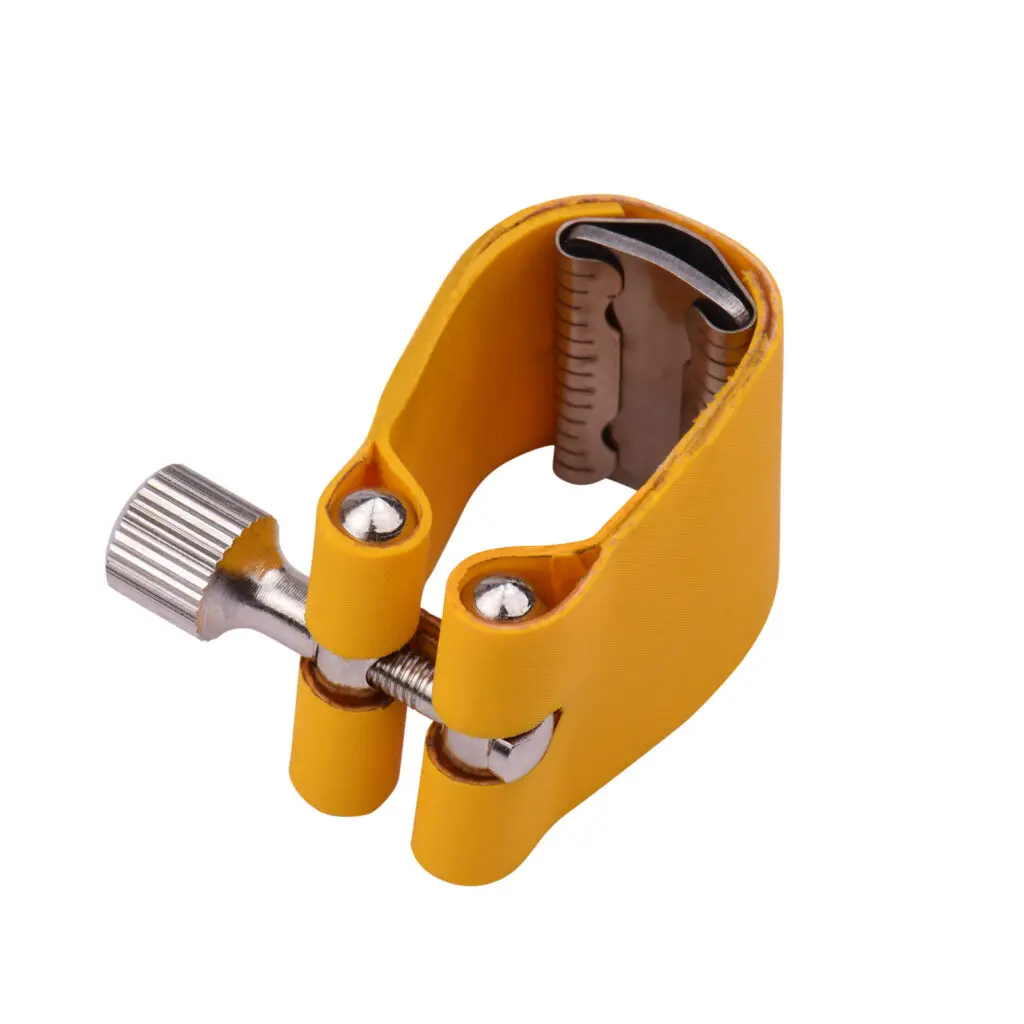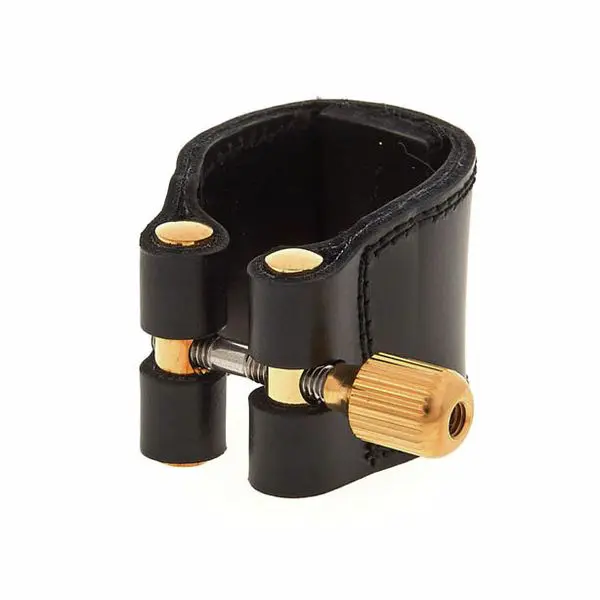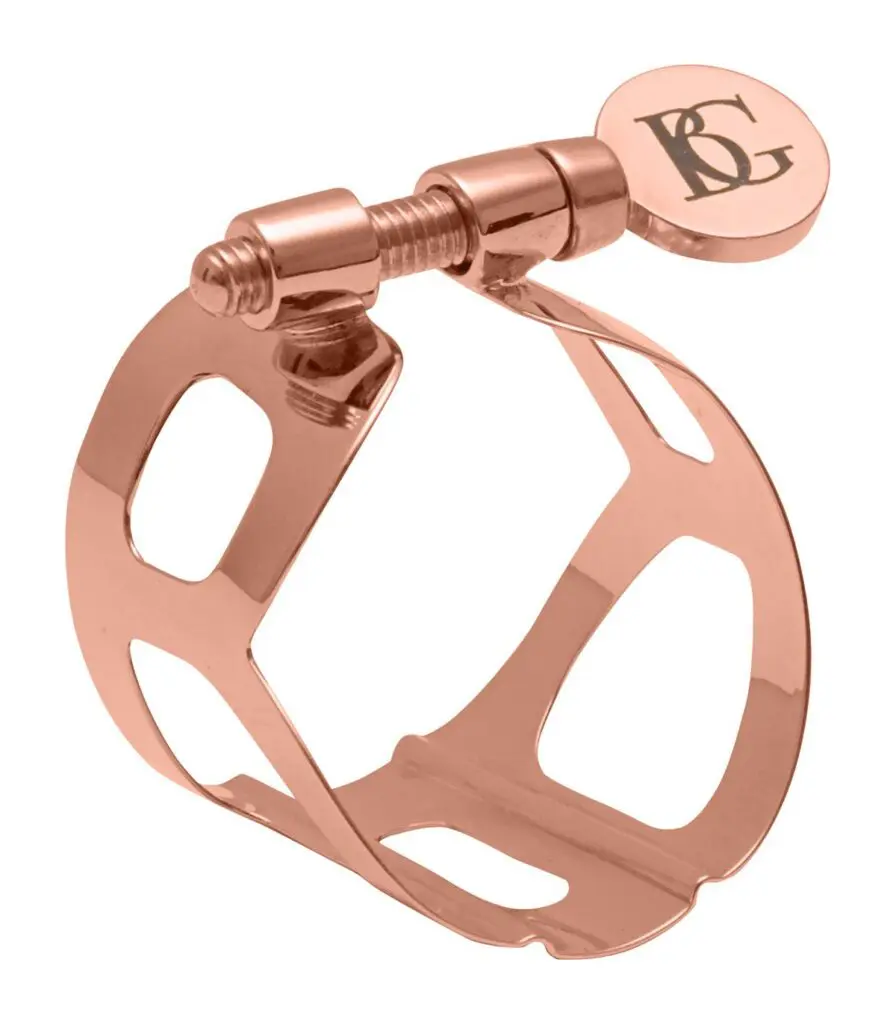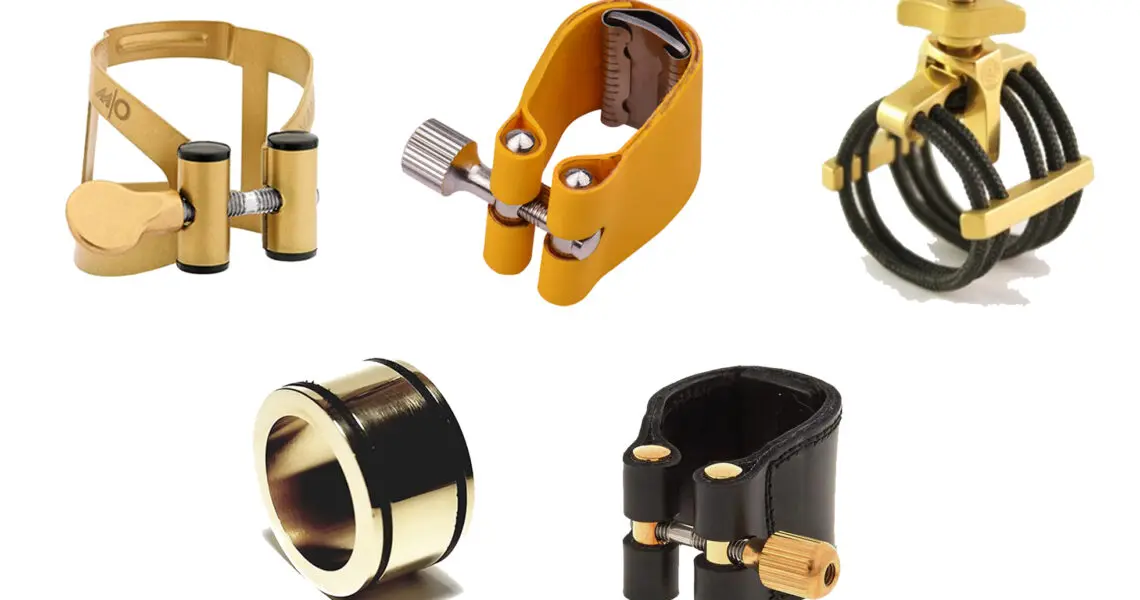Playing the saxophone is a whole ensemble of skills and parts that combine themselves to produce beautiful music so today we will talk about the saxophone ligature, a small implement that plays a big role in saxophone music.
What is a saxophone ligature?
The sax ligature is the small part that attaches the reed to the mouthpiece. The combination of the reed, mouthpiece, and ligature is what’s called the setup.
Although the effects of a ligature are less obvious than those from the saxophone mouthpiece and reed, most players put a lot of thought into choosing the ligature because it impacts the way playing your saxophone feels.
What is the main function of a saxophone ligature?
The saxophone ligature’s sole purpose is to secure the reed to the mouthpiece table allowing the reed to vibrate freely.
The impact of the ligature on the sound and the musician’s ease of playing depends on the reed’s compression points, where it is placed, the pressure applied by the ligature, and the material.


Materials used for sax ligatures, which is the best?
Most saxophone ligatures are made from thin metal with two screws on the underside of the mouthpiece.
However, they are not always made with top quality, may hinder reed vibration, and can be easily broken.
There are many high-quality ligatures in the market made from brass, fabric, gold, leather, nickel, nylon, plastic, rubber, silver, and even wood, among others.
You can also find different styles, including ligatures without screws or designs using pressure plates.
The durability of a ligature will depend on the materials used to make them. However, most durable ligatures are made of leather or metal.


Fitting a ligature
When you are placing the sax ligature on the mouthpiece you should do it with care, so you don’t cause any damage to the reed in the process.
Where does the ligature go on a saxophone?
The reed should be placed on the mouthpiece first and held in place, then carefully slip the ligature over the mouthpiece and reed without touching the reed’s tip.
The ligature needs to be lined up in the center of the reed only touching the bark and not the filled portion.
To determine the exact saxophone ligature placement that best works for you, you will need to experiment and try to see its response.
How to tighten the ligature?
Once you place the ligature, use the screws to tighten it enough so it holds the reed snugly in place.
Be careful you don’t tighten too much because it will impact the reed’s response and you may also break the ligature.
Also, it’s important to mention that among various ligatures the placing might be different and it needs to be done as instructed in ligature documentation.
How tight should a saxophone ligature be?
There should be a balance in its tightness because if it’s too tight it won’t allow the reed to vibrate freely so the sound and tone will be off.
And if it’s too lose you risk the mouthpiece getting detached from the sax.
There’s not a way to measure tightness, so you will need to trust how you feel it and try it out.
Why are the ligatures important?
The reason the saxophone ligature is important is that, since it’s in direct contact with the mouthpiece and reed, it has a great impact on the tone, harmonics, and response of the instrument.
Also, as we’ve mentioned before, it holds the mouthpiece into place, and without a correctly functioning mouthpiece, there’s no music.
Does the ligature make a difference or affect the sound?
The decision of what ligature works best will be based solely on the way the reed feels to the sax player because the changes in tone are not exclusively dependent on the ligature.
However, the construction of the ligature will allow the reed to vibrate correctly, and the plates used in some of the saxophone ligatures can distort and change the overall tone of the sax, as well as help with its resonance.
What are the must-haves of a high-quality saxophone ligature?
The first factor to consider when you’re looking for a good ligature is that it is a good fit for your mouthpiece and has a secure grip on the reed.
The mouthpiece and the reed need to be secure, that is where the ligature comes to play. It needs to be tight, but not so much that it blocks the reed’s vibrations.
High-quality ligatures shouldn’t need to be changed frequently; most will even last a lifetime with proper care.
But at the end of the day the ligature’s durability will depend on the material used. As we’ve said before, most durable ligatures are made of leather or metal.
Another factor in the process of choosing a ligature is your budget.
You will be able to find beginners ligatures for around $20, but if you are a more experienced player and want a more high-end product, the ligature price could range up to $100.
Should you get a new ligature or is the default one good?
As long as the default ligature is holding the reed firmly on the mouthpiece and you can make the necessary adjustments on the mouthpiece without disturbing the reed, then there’s no need to change it.
However, if you are not comfortable with the default ligature and how you feel the vibrations on the reed, then you may invest in a new one.
It’s a matter of personal choice or damage to the reed. Default ligatures can be considered good enough if they serve their purpose.
There’s a wide variety of ligatures to fit every taste and demand, but there’s not one “best saxophone ligature”.
Why are there so many varieties of ligatures?
The reason you will find so many ligature styles is that mouthpieces come in different shapes and sizes and sometimes you will need a special kind to fit your mouthpiece.
Some mouthpieces have odd shapes and with ligatures, the saying “one size fits all” doesn’t apply.
Also, it might be a matter of durability because the material it was made of will determine how long it will last.
Things to consider when buying a new saxophone ligature?
If you’re a beginner, you may start with a basic ligature because it does the job and it’s the least expensive of all.
Saxophones come with a ligature, and it will work just as well.
On the other hand, pro ligatures are designed with more specifications and are made to last longer.
You will find pro ligatures are made for playing either jazz or classical music and are supposed to aid in getting a brighter, or darker, tone, have crisp articulation, and better response.
Also, you could get a cleared altissimo, more flexibility, and greater stability, among many other pros.
Price range of ligatures
There’s a wide price range regarding ligatures. You can find them as low as $20, for a basic one, and up to $100 or more for the proline.
Our top choice for best Sax ligatures
We researched what pro sax players have said about the top sax ligatures and this is what we compiled.
3 top ligatures soprano sax
The Rovner 1RVS soprano saxophone ligature is made from synthetic leather and it’s been a jazz sax player’s favorite because it produces a dark and resonant tone that balances the high-pitched soprano sax.
It’s one of the most inexpensive you will find but it’s also very durable even for students.
Then we have the BG’s Super Revelation ligature made from fabric but with a 24k gold plated metal plate which, since it makes direct contact with the reed, allows better articulation, and creates a warm and full tone.
Finally, we have the an-do-er Leather Ligature Fastener designed for soprano sax with Bakelite mouthpieces.
It comes with a plastic saxophone ligature cap to prevent chipping and damage to the mouthpiece.
This saxophone ligature helps to improve sound and to achieve a more even tone.
3 top ligatures for alto sax
Again, one of the top alto saxophone ligatures is Rovner Alto Sax Ligature 1RL will greatly improve reed playability, even with reeds that’ve been deemed unplayable.
Rovner ligatures have been designed to fit a wide range of mouthpieces and to last a long time.
The Jiayouy Alto Sax Mouthpiece Ligature with double adjustable screws is a versatile option because it’s compatible with most alto saxophone models.
It’s made from gold plated brass and not only helps to achieve a rich tone, but it also looks elegant and it’s a great protection for your mouthpiece.
Another favorite is the Vandoren LC07P Optimum Ligature which, although it was released 20 years ago, is still one of the best on the market.
It comes with three interchangeable pressure plates to allow you to regulate the contact with the reed, resulting in a wide variety of sound profiles.
3 top ligatures for tenor and bass sax
For tenor sax there’s the Yamaha YAC 1611 ligature made from metal with lacquered brass finish that gives it an elegant look and adjustable screws. It’s compatible with all Yamaha tenor saxes.
The Rovner Tenor Sax Ligature 2R is a top selling product. It doesn’t have pressure points and the reed and the way it’s intended to be placed helps reduce stuffiness and achieve tonal clarity, as well as warm sounds.
Vandoren LC58DP M/O Ligature also comes with a plastic cap, double track screw mechanism, it’s very easy to set up and has inverted tightening with two small contact points on the reed.
Top 5 saxophone ligatures for playing jazz
In our search for the best jazz sax ligature, we found the BG Revelation Jazz Ligature which is made from fabric and aimed at jazz players.
It features a silver-plated surface with dual rails where the ligature contacts the reed to ease articulation of the reed and in consequence brighter and clearer tone.
Silverstein Works Original Saxophone Ligature is made with an interspersed dotted cord which allows the reed to vibrate freely and includes a metal part modified to produce a more resonant sound.
Wood Stone Metal Ligatures have a more classic look, with two adjustment screws, and come in different metal shades, such as silver and rose gold.
Its design is simple but enables optimum reed vibration for a full, warm sound.
Others consider the Vandoren Optimum as the best ligature for jazz. It comes with three different pressure plates to use according to the tone you want to achieve.
You can even use a pressure plate for jazz and another for classical, so it’s a very versatile ligature.
We can’t leave out Rovner, and in this case, the Rovner LIGHT is aimed at jazz improvisers or those who like a more contemporary sound.
It’s made from fabric so with time it will mold to the shape of the mouthpiece.
Final thoughts
Every part and component of a saxophone has a role to play and makes a vital part of the art of sax music.
So, when choosing the best saxophone ligature for your specific needs and that fit your skills, always make an informed and educated decision, because even if it’s a little and almost imperceptible, the impact of the saxophone ligature is no less important than the selection of the whole setup.
If you’re interested in exploring the setup further, make sure to check out our guide on Saxophone reeds as well as our article to help you in choosing a saxophone mouthpiece in 2022!

